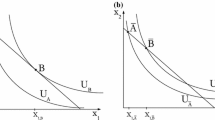Abstract
Modeling a North American Free Trade Area: Estimation of Flexible Functional Forms, - This paper provides estimates of the almost ideal demand system as applied to U.S. imports from Canada, Mexico, the rest of the world, and competing domestic output. Quarterly data over 1980-88 and for 19 mining and manufacturing sectors are used. Implications of adding up, homogeneity, symmetry, and negativity are considered. The econometric results should guide applied general equilibrium modeling of a North American Free Trade Area, especially with regard to potential terms-of-trade effects.
Zusammenfassung
Zur Modellierung einer Nordamerikanischen Freihandelszone. Schätzung von flexiblen Funktionsformen. - Dieser Aufsatz liefert Schätzungen für das Konzept des ‘Fast idealen Nachfragesystems” (almost ideal demand system), das angewandt wird auf U.S.-Importe aus Kanada, Mexiko, dem Rest der Welt und auf die konkurrierende heimische Produktion. Benutzt werden Vierteljahresdaten aus den Jahren 1980 bis 1988 für neunzehn Bergbau- und Industriesektoren. Untersucht wird, ob die Adding-up-, Homogenitäts-, Symmetrie- und Negativitätsbedingungen erfüllt sind. Die ökonometrischen Ergebnisse sollten bedacht werden bei der Erarbeitung eines angewandten allgemeinen Gleichgewichtsmodells für eine Nordamerikanische Freihandelszone, insbesondere im Hinblick auf mögliche Folgen für die Terms of Trade.
Similar content being viewed by others
References
Barten, Antonius P., “Maximum Likelihood Estimation of a Complete System of Demand Equations.”European Economic Review, Vol. 1, 1969, pp. 7–73.
Brown, Drusflla K., “Tariffs, the Terms of Tade, and National Product Differentiation.”Journal of Policy Modeling, Vol. 9, 1987, pp. 503–526.
Deaton, Angus, John Muellbauer, “An Almost Ideal Demand System.”The American Economic Review, Vol. 70, 1980, pp. 312–326.
Diewert, W. Erwin, Terence X Wales, “Flexible Functional Forms and Global Curvature Conditions.”Econometrica, Vol. 55, 1987, pp. 43–68.
Grossman, Gene M., “Import Competition from Developed and Developing Countries.”The Review of Economics and Statistics, Vol. 64, 1982, pp. 271–281.
Hinojosa-Ojeda, Raul, Sherman Robinson,Alternative Scenarios of U.S.-Mexico Integration: A Computable General Equilibrium Approach. Department of Agricultural and Resource Economics, University of California, Working Paper No. 609. Berkeley 1991.
Markusen, James R., Randall M. Wigle, “Nash Equilibrium Tariffs for the United States and Canada: The Roles of Country Size, Scale Economies, and Capital Mobility.”Journal of Political Economy, Vol. 97, 1989, pp. 368–386.
Norman, Victor D., “Assessing Trade and Welfare Effects of Trade Liberalization: A Comparison of Alternative Approaches to CGE Modelling With Imperfect Competition.”European Economic Review, Vol. 34, 1990, pp. 725–745.
Perroni, Carlo, Thomas F. Rutherford,Regularly Flexible Functional Forms for Applied General Equilibrium Analysis. Centre for the Study of International Economic Relations, Department of Economics, University of Western Ontario, Working Paper No. 8906C. London, Canada, 1989.
—, —,Regular Flexibility of Nested CES Functions. Department of Economics, Wilfried Laurier University. Waterloo, Ontario 1992, unpublished.
Pollak, Robert A., Terence J. Wales, “Specification and Estimation of Nonseparable Two-Stage Technologies: The Leontief CES and the Cobb-Douglas CES.”Journal of Political Economy, Vol. 95, 1987, pp. 311–333.
Reinert, Kenneth A., Clinton R. Shiells,Estimated Elasticities of Substitution for Analysis of a North American Free Trade Area. Office of Economics, U.S. International Trade Commission, Staff Research Study 19. Washington, D.C., 1992.
ShieUs, Clinton R., “Competition and Complementarity between U.S. Imports from Developed and Newly Industrializing Countries.”Weltwirtschaftliches Archiv, Vol. 125, 1989, pp. 114–128.
-,Kenneth A. Reinert, “Armington Models and Terms-of-Trade Effects: Some Econometric Evidence for North America.”Canadian Journal of Economics, 1993, forthcoming.
—,Robert M. Stern, Alan V. Deardorff, “Estimates of the Elasticities of Substitution between Imports and Home Goods for the United States.”Weltwirtschaftliches Archiv, Vol. 122, 1986, pp. 497–519.
Varian, Hal R., “The Nonparametric Approach to Demand Analysis.”Econometrica, Vol. 50, 1982, pp. 945–973.
—, “Nonparametric Tests of Consumer Behaviour.”The Review of Economic Studies, Vol. 50, 1983, pp. 99–110.
Winters, L. Alan, “Separability and the Specification of Foreign Trade Functions.”Journal of International Economics, Vol. 17, 1984, pp. 239–263.
—, “Comments: ‘Assessing Trade and Welfare Effects of Trade Liberalization. A Comparison of Alternative Approaches to CGE Modelling with Imperfect Competition’ by V.D. Norman.”European Economic Review, Vol. 34, 1990, pp. 746–751.
About this article
Cite this article
Shiells, C.R., Roland-Hoist, D.W. & Reinert, K.A. Modeling a north American free trade area: Estimation of flexible functional forms. Weltwirtschaftliches Archiv 129, 55–77 (1993). https://doi.org/10.1007/BF02707487
Published:
Issue Date:
DOI: https://doi.org/10.1007/BF02707487




